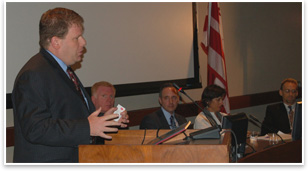|
AIA Transportation Forum Places Transit as the Foundation of Sustainable Communities
by Zach Mortice
Associate Editor
Summary: A diverse group of infrastructure and planning officials came together at the AIA national headquarters in Washington, D.C., this week to come to some common conclusions about the nation’s transportation needs. At the top of the list: a unified and collaborative approach that reaches across levels of government and state and municipal lines and a recognition that a 21st century sustainable transit system must act as a building block towards more sustainable and livable communities.

The asset design professionals bring is the ability to integrate, Andrew Goldberg told the conference assembly September 21. Seated panelists include, from left, Jim Dinegar, Stewart Schwartz, Jodye Russell, and Andy Kunz. Photo by Douglas Gordon, Hon. AIA.
AIA national and AIA DC hosted the forum as part of DC Architecture Week, and also to spur debate in the wake of congressional debate over a federal transportation reauthorization bill. Panelists included Jim Dinegar, president of the Greater Washington Board of Trade; Andy Kunz, of the U.S. High Speed Rail Association; Stewart Schwartz, the executive director of the Coalition for Smarter Growth; Andrew Goldberg, Assoc. AIA, director of AIA federal relations; and Jodye Russell, of the D.C. Water and Sewer Authority. The next forum will take place in Pasadena, Calif., on Oct. 21.
Though the transportation bill has been introduced in the House, the Obama Administration has asked that it be shelved for the next 18 months so Congress can deal with other projects sooner. From the outset, Kunz discussed how transportation infrastructure problems are at the core of most of the issues Congress has placed as a higher priority. Examples, he said, include peak oil prices, climate change, transportation paralysis and congestion, a failing economy and lost jobs, as well as crumbling infrastructure.
Goldberg and his federal government advocacy team at the AIA are urging Congress to act on the transportation bill now for these very reasons. “If you look at the big issues that Congress is dealing with—healthcare, the economy, climate change—transportation impacts all of them,” he said. “It impacts the economy. We lose about $80 billion a year because of [traffic] congestion. Think about healthcare—the way we design communities to force people, [especially children], to drive everywhere and not walk. Think about childhood obesity rates. And of course climate change. The transportation system we have is one of the main contributors of green house gases—not just from cars, but from the ways buildings are laid out.”
Schwartz stressed the importance of combining sustainable mass transit options with dense, sustainable development patterns that capitalize on infrastructure that has already been built—what he calls “location efficiency.” “Putting green, energy efficient buildings in the ground is great, but not if you have to drive there for every trip,” he said.
The overlapping layers of government authority needed to create such growth will have to be developed together, with transit, water and sewer, housing, infrastructure, and economic development federal and state agencies coordinating their efforts, Schwartz said. Locally, Russell said this meant getting the District of Columbia DOT to work with the D.C. Water and Sewer Authority. Dinegar said he’d like to see the governments of D.C., Maryland, and Virginia spend more time working together to plan out transportation and development policies. In this way, transit is really only one part of the puzzle of developing wholly sustainable communities. Each panelist reaffirmed that the sustainable practices (mass transit, dense and walkable neighborhoods, mixed uses) that make up successful urban neighborhoods can’t exist in isolation.
Architects, as creative collaborators adept at building consensus around the sculpting of communities, are best equipped to untangle the priorities and goals of the nation’s mass transit and sustainable urbanism needs, Goldberg said. “The asset that design professionals bring isn’t simply the ability to design things well or understand building codes or physics, but to integrate different things,” he said. “[It’s] the ability to talk about planning in a holistic way so you can get transportation systems that work with communities.”
At the end of the event, one audience member asked about the need to begin a national dialogue and public education campaign on the state of infrastructure in the country. “I think there needs to be one, and I think architects, along with planners, engineers, contractors, public health advocates, and many more need to have a collaborative effort in leading the discussion,” said Adam Melis, director of AIA advocacy outreach. “This is why AIA national and AIA DC held this forum and why we hope other AIA components will join us.” |


